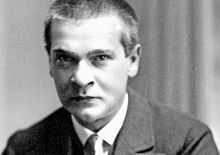Sebastian in a dream
Sebastian im Traum is a collection of lyrical works by the Austrian expressionist and symbolist poet Georg Trakl . It was published posthumously in the spring of 1915 by K. Wolff Verlag .
The best-known works in this volume include Sebastian im Traum (eponymous), Kaspar Hauser Lied , Der Herbst des Einsamen , one of the few prose texts by Trakl's Dream and Disorder and the fourth version of the poem Abendland , which is dedicated to Else Lasker-Schüler .
Edition history
After Georg Trakl's first collection of poems published in July 1913 by K. Wolff Verlag as part of the book series Derjungste Tag (Volume 7/8), he announced a second collection of poems in 1914, which, in accordance with the contract for the publication of poems concluded in the previous year, would also be published in the K Wolff Verlag should appear. Similar to poems , Trakl often revised his works and groupings, asking the publisher to take his changes into account. This is how some of the poems from the previous volume found their way into this second collection. Due to these proposed changes, which lasted until May, and various delivery bottlenecks caused by the First World War , Sebastian only appeared in a dream in the spring of 1915 after Trakl's death in November 1914 posthumously as announced in the K. Wolf Verlag.
After Sebastian im Traum , the last seven works appeared posthumously in the Brenner yearbook , which were created between June and October. These include Klage and Grodek , which he wrote shortly before his death and sent to Ludwig von Ficker .
Interpretative approaches
The volume contains the poem cycles Sebastian im Traum with 15 poems, The Autumn of the Lonely with eight poems, Siebengesang des Tod with 15 poems, Song of the Secluded with ten poems as well as the prose text Traum und Umnnung . Delusion , sadness , loneliness , wishes for redemption and manifest hopelessness are the main themes of this volume. The contrasts and contradictions of dying and spring as well as death and birth , which greatly with the help of the images come into play are, by nominalization of adjectives ( "A Dark," "A Rotting", "A Silver") and its increase in the sense of support . The non-natural motifs contained , consisting of allegorical colors, increasingly encode the overall impression.
“ The sleeper appeared more
and more descending the black forest, And a blue spring rushed in the ground,
That gently lifted
his pale eyelids over his snowy face;
And the moon drove a red animal
out of its cave;
And the dark lament of women died in sighs.
( Song of Seven of Death ) "
Even Christian mysticism can be for example in Sebastian in a dream find.
“ Peace of the soul. Lonely winter evening,
The dark figures of the shepherds by the old pond;
Little children in the hut of straw; Oh how softly
the face sank in black fever on
Holy Night. "
This biblical configuration of Christian images and the wishes for redemption, for example with the singing of the departed , come close to a manifesto . The text Traum und Umnnung contained in the volume is one of the few prose texts by Trakl.
literature
- Bernd Matzkowski: Text analysis and interpretation of Georg Trakl, Das lyrische Schaffen. All necessary information for the Abitur, Matura, exam and presentation plus sample exercises with possible solutions. (= King's Explanations Special ). Bange, Hollfeld 2011, ISBN 978-3-8044-3061-7 .
- Harald Hartung: From Naturalism to the Middle of the 20th Century. (= Poems and interpretations. 5). (= Reclams Universal Library . 7894). Reclam, Stuttgart 2011, ISBN 978-3-15-007894-5 .
- Heinz Ludwig Arnold : Kindlers Literature Lexicon . 3rd, completely revised edition, volume 16. 18 volumes. Metzler, Stuttgart 2009, ISBN 978-3-476-04000-8 , pp. 403-404.
reception
Parts of the poem cycle were set to music, including by Wolfgang Rihm and Hans Werner Henze : Sebastian im Traum (2004) for large orchestra (based on the poem of the same name by Georg Trakl). Premiere December 22, 2005 Amsterdam (Concertgebouw Orchestra, conductor: Mariss Jansons ).
Web links
Individual evidence
- ↑ a b c d Bernd Matzkowski: Text analysis and interpretation of Georg Trakl, Das lyrische Schaffen. All necessary information for the Abitur, Matura, exam and presentation plus sample exercises with possible solutions. (= King's Explanations Special ). Bange, Hollfeld 2011, ISBN 978-3-8044-3061-7 .
- ↑ a b c d (article) Georg Trakl. Heinz Ludwig Arnold : Kindlers Literature Lexicon . 3rd, completely revised edition, volume 16. 18 volumes. Metzler, Stuttgart 2009, ISBN 978-3-476-04000-8 , p. 403F. Biogram, article on Georg Trakl by Peter Schünemann / Marion Bönnighausen.
